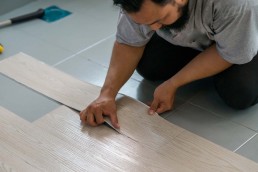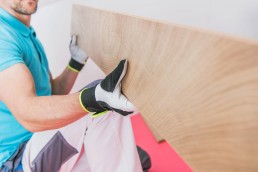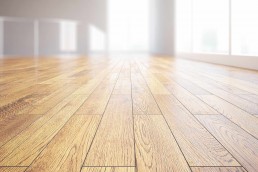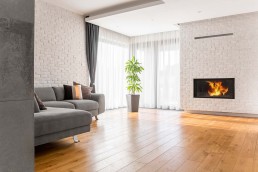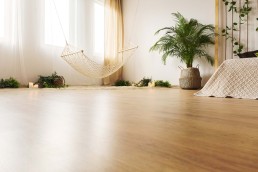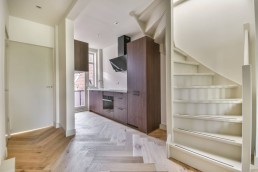Where Should You (and Shouldn’t You) Install LVP Flooring?
Luxury Vinyl Plank (LVP) flooring has exploded in popularity thanks to its durability, affordability, and realistic wood-look design. But while LVP is marketed as a “do-it-all” flooring solution, the truth is—it’s not perfect for every room or condition.
In this guide, we’ll break down exactly where you should (and shouldn’t) install LVP flooring, so you can make the best decision for your home or property.
Where You Should Install LVP Flooring
1. Living Rooms & Bedrooms
Why it works:
LVP provides a warm, wood-look finish that’s soft underfoot and perfect for everyday use. It’s scratch-resistant and great for homes with kids or pets.
💡 Bonus: Many homeowners choose LVP over hardwood for its lower cost and easier maintenance.
2. Kitchens
Why it works:
LVP is water-resistant (often waterproof) and can withstand occasional spills, dropped dishes, and high traffic. Unlike real hardwood, it won’t warp from everyday kitchen moisture.
💡 Pro tip: Look for LVP with a wear layer of at least 12 mils for kitchen durability.
3. Bathrooms
Why it works:
Because of its waterproof core (SPC or WPC) and tight click-lock seams, LVP is a great alternative to tile in bathrooms. It won’t absorb moisture or promote mold growth underneath.
🚫 Watch out: Avoid using LVP in bathrooms without proper ventilation or where standing water may sit for long periods.
4. Laundry Rooms & Mudrooms
Why it works:
These utility spaces deal with high humidity and potential leaks—areas where traditional hardwood would fail. LVP handles moisture and impact exceptionally well.
5. Finished Basements
Why it works:
Basements are notorious for moisture issues and temperature swings. Engineered LVP flooring won't warp or buckle like hardwood or laminate. It’s a solid choice for finished lower levels.
🔧 Installation tip: Use an underlayment with a built-in vapor barrier if installing over concrete.
6. Pet-Friendly Homes
Why it works:
LVP resists scratches from claws, is easy to clean, and doesn’t trap pet odors. It's an excellent surface for households with dogs or cats.
Where You Shouldn’t Install LVP Flooring
🌧 1. Outdoors or Unheated Spaces
Why not:
LVP is not rated for direct outdoor use, such as decks or porches. It also isn’t suitable for unheated sunrooms or garages where temperatures can drop below freezing or rise above 120°F.
2. Subfloors with High Moisture (Without Prep)
Why not:
LVP is water-resistant, not invincible. If you install it over a wet concrete slab or an unsealed crawlspace, you risk trapped moisture, mold, or adhesive failure.
🧰 Solution: Use a moisture barrier and test for vapor emissions before installation.
3. Around Fireplaces or Near Heat Vents (Excessive Heat)
Why not:
While LVP is heat-tolerant, direct or prolonged exposure to high temperatures (e.g., next to a wood-burning stove or floor registers with no deflector) may cause discoloration or warping.
4. Commercial Kitchens or Industrial Areas
Why not:
Even though LVP is durable, it's not designed for extreme heat, grease, or heavy rolling loads. These spaces often require commercial-grade tile or epoxy flooring instead.
Quick Reference: LVP Installation Guide
| Room / Space | Recommended? | Notes |
|---|---|---|
| Living Room | ✅ Yes | Great residential use |
| Bathroom | ✅ Yes | Waterproof LVP preferred |
| Kitchen | ✅ Yes | Choose durable wear layer |
| Basement (Finished) | ✅ Yes | Use vapor barrier |
| Outdoor Deck | ❌ No | Use tile or composite decking |
| Garage (Unheated) | ❌ No | Consider sealed concrete or tile |
| Laundry Room | ✅ Yes | Moisture-resistant option |
| Commercial Kitchen | ❌ No | Requires heavy-duty flooring |
Final Thoughts: Is LVP Flooring Right for Your Space?
LVP flooring is incredibly versatile, but like any product, it has its limits. It’s ideal for most residential settings, especially high-moisture and high-traffic areas. Just be cautious when using it in unheated, outdoor, or industrial environments.
Still unsure if LVP will work in your space? Our flooring experts are here to help you find the perfect solution for your lifestyle and budget.
Engineered vs. Solid Hardwood Flooring: Which One Is Right for You?
When it comes to choosing hardwood flooring, one of the biggest decisions homeowners face is: engineered hardwood or solid hardwood? Both offer the timeless beauty of real wood, but they differ significantly in structure, performance, and cost.
In this guide, we’ll break down the key differences, pros and cons, and help you decide which option is best for your home.
What’s the Difference Between Solid and Engineered Hardwood?
-
Solid hardwood flooring is made from a single piece of real wood, typically ¾” thick. It can be sanded and refinished multiple times over its lifespan.
-
Engineered hardwood flooring consists of a thin top layer of real wood (called the veneer) bonded to multiple layers of plywood or HDF underneath. This construction makes it more stable, especially in areas with humidity or temperature fluctuations.
Pros and Cons of Solid Hardwood Flooring
Pros
-
Long lifespan – Can be refinished multiple times (up to 4–6 times).
-
Classic aesthetic – Deep grain and natural character.
-
Increases home value – Seen as a premium flooring option.
-
Custom stain options – Easily sanded and stained to match design trends.
Cons
-
Sensitive to moisture – Prone to expansion and contraction in humid environments.
-
Not recommended for basements or concrete slabs.
-
More expensive – Higher material and installation costs.
-
Installation limitations – Must be nailed or stapled down, not suitable for floating floors.
Pros and Cons of Engineered Hardwood Flooring
Pros
-
More stable – Less prone to warping and cupping, ideal for kitchens, basements, and over radiant heating.
-
Easier installation – Can be glued, stapled, or floated.
-
More affordable – Typically costs less than solid hardwood.
-
Wider plank options – More flexibility with sizes and finishes.
Cons
-
Limited refinishing – Depending on veneer thickness, may only allow 1–2 sandings.
-
Quality varies – Cheaper products may have thin wear layers.
-
Not as long-lasting – Typically has a shorter lifespan than solid wood.
Where to Use Solid vs. Engineered Hardwood
| Room/Condition | Best Choice |
|---|---|
| Dry, climate-controlled spaces (e.g., bedrooms, living rooms) | Solid Hardwood |
| Basements or areas with humidity | Engineered Hardwood |
| Over radiant heat systems | Engineered Hardwood |
| On concrete slab | Engineered Hardwood |
| Renovations with height restrictions | Engineered Hardwood |
| Historic home restorations | Solid Hardwood |
Sustainability Note
Engineered hardwood uses less slow-growing hardwood than solid planks, making it a more eco-conscious option when sourced responsibly. Look for FSC-certified products if sustainability is a priority.
Which Hardwood Flooring Is Right for You?
Choose solid hardwood if:
-
You want maximum longevity
-
You’re installing above grade in a dry area
-
You prefer traditional installation and design flexibility
Choose engineered hardwood if:
-
You need stability in variable climates
-
You’re renovating over concrete or radiant heating
-
You want a budget-friendly option that still uses real wood
Need Help Choosing the Right Hardwood?
Whether you're remodeling a single room or building your dream home, we can help you find the perfect flooring for your lifestyle and budget.
Contact us at Focus Flooring in Peterborough today to have one of our experts guide you to the right option for your project.
How to Match LVP Floors with Your Cabinets, Walls, and Trim
LVP floors are a smart, stylish choice for today’s homes. With endless color and texture options, they offer the beauty of hardwood with more durability and less maintenance. But once you've chosen your perfect flooring, a big question remains:
How do you match your LVP floors with cabinets, wall colors, and trim for a cohesive look?
In this guide, we’ll walk you through expert tips on coordinating finishes, tones, and textures — so your home looks polished and professionally designed.
1. Understand the Undertones of Your LVP Floors
Before picking paint or cabinet colors, study the undertones of your LVP floors. Most fall into one of these categories:
-
Warm tones – golden, honey, red-brown, or beige
-
Cool tones – gray, ash, taupe, or driftwood
-
Neutral tones – balanced blends of gray and brown
Tip: Hold a white sheet of paper next to your flooring. This can help make undertones pop out clearly.
2. Coordinate Cabinets with Contrast
Matching cabinets exactly to your LVP floors can make your space feel flat. Instead, use contrast to create depth:
-
Warm LVP floors (like chestnut or caramel): Try white, cream, or olive-green cabinets.
-
Cool LVP floors (like gray oak): Pair with navy, charcoal, or soft blue cabinets.
-
Neutral floors: Almost anything works — but matte black or sage green is very trendy right now.
Bonus Tip: Two-tone cabinets (light uppers + dark lowers) pair beautifully with LVP floors.
3. Wall Colors That Work with LVP Floors
Wall colors should enhance — not overpower — your floors. Here’s how to get it right:
| LVP Floor Type | Recommended Wall Colors |
|---|---|
| Light oak or beige | Soft whites, sage green, pale blue |
| Gray or greige | Cool whites, dusty lavender, navy |
| Dark wood looks | Cream, warm white, tan, or blush |
Pro Move: Test samples on the wall next to the floor at different times of day.
4. Trim: Keep It Crisp and Classic
When in doubt, go white with trim. Clean white trim adds contrast, frames your flooring, and suits almost any style.
If you're feeling bold:
-
Use greige or mushroom trim for a softer, earthy vibe
-
Try black trim with light LVP floors for a sleek modern edge
5. Use Samples and Mood Boards
LVP floors come in a wide range of finishes, so use physical samples or digital tools to create a design board. Include:
-
A flooring swatch
-
Cabinet sample or paint chip
-
Wall color card
-
Trim paint sample
Tools like Canva, Pinterest, or real wood/paint swatches from your local hardware store can help you visualize everything together.
Final Thoughts: Let Your LVP Floors Lead the Way
Choosing the right combination of floors, cabinets, walls, and trim doesn’t have to be overwhelming. Let your LVP floors set the tone, and use contrast, balance, and texture to guide the rest.
With a little planning, your space will feel beautifully intentional — and totally you.
How to Protect Your Hardwood Floors from Muddy Paws This Spring
Spring brings sunshine, blooming flowers... and muddy paws.
If you have pets, you know the struggle is real — muddy footprints can quickly ruin the beauty and lifespan of your hardwood floors.
Don't worry! With a few smart tips, you can enjoy the season without stressing about damage.
In this guide, we’ll show you how to protect your hardwood floors from muddy paws this spring — and keep them looking flawless year-round.
1. Create a Pet Cleaning Station by the Door
Set up a small cleaning area near every entrance your pets use.
Stock it with:
-
A towel or microfiber cloth
-
A shallow water tray for rinsing paws
-
A pet-safe mat for wiping feet
Pro Tip: Teach your dog to "wait" while you clean their paws — it’ll save you tons of time (and mopping).
2. Invest in Durable Entryway Rugs
Entryway rugs are your first line of defense.
Look for rugs that are:
-
Waterproof or quick-drying
-
Non-slip to avoid accidents
-
Machine washable for easy cleanup
Best placement: Inside and outside every exterior door.
3. Use a Pet-Safe Floor Cleaner Regularly
Spring mud carries more than just dirt — it can hide salts, fertilizers, and chemicals that damage wood.
Clean floors frequently using a pH-neutral, pet-safe hardwood cleaner.
Avoid harsh chemicals like bleach or ammonia that can strip your floor’s finish.
4. Apply a Protective Sealant or Recoat
If your hardwood floors are due, spring is the perfect time to recoat.
A fresh layer of polyurethane protects against moisture, stains, and scratches.
Not sure if you need a new coat?
Try the water-drop test: If water soaks in quickly, it’s time!
5. Keep Pet Nails Trimmed
Long nails can dig into wood and cause scratches — especially when your dog runs excitedly inside after a walk.
Regular trimming (or professional grooming) keeps nails short, smooth, and floor-friendly.
Bonus: It’s healthier for your pet too!
Final Thoughts: A Little Prep Goes a Long Way
Protecting your hardwood floors from muddy paws this spring doesn’t have to be difficult.
With a smart cleaning routine, a few key supplies, and a little training, you can enjoy a clean, beautiful home — and happy pets.
The Ultimate Guide to Luxury Vinyl Plank (LVP) Flooring Care in Spring
As the seasons change and spring arrives, it’s important to give your Luxury Vinyl Plank (LVP) flooring the attention it deserves. While LVP is known for its durability and low maintenance, seasonal changes such as increased humidity, foot traffic, and allergens can impact its appearance and longevity. In this guide, we’ll walk you through essential LVP flooring care tips to keep your floors looking flawless throughout spring.
1. Manage Humidity and Temperature Changes
Spring often brings fluctuating humidity levels, which can cause expansion and contraction in some flooring materials. Fortunately, LVP is more resistant to these changes than hardwood, but it’s still a good idea to maintain indoor humidity levels between 30-50% to prevent any potential warping. Using a dehumidifier or air conditioner can help regulate indoor moisture levels.
2. Deep Clean After Winter
Winter often leaves behind dirt, salt, and moisture that can dull the appearance of LVP flooring. Give your floors a deep clean at the start of spring to restore their shine:
- Sweep or vacuum with a soft brush attachment to remove debris.
- Mop with a damp microfiber mop and a pH-neutral cleaner designed for LVP.
- Avoid excessive water or steam cleaning, as moisture can seep into seams and weaken the adhesive.
3. Protect Against Spring Allergens
Springtime means pollen, dust, and pet dander, which can settle on your LVP flooring. Reduce allergens by:
- Vacuuming or sweeping regularly to remove buildup.
- Using doormats at entry points to trap outdoor allergens before they reach your floors.
- Wiping down floors with a damp mop to eliminate fine dust and pollen particles.
4. Prepare for Increased Foot Traffic
Warmer weather often means more visitors, kids playing indoors, and pets tracking in dirt. Protect your LVP flooring by:
- Placing rugs or mats in high-traffic areas to reduce wear.
- Using furniture pads to prevent scratches from heavy furniture movement.
- Encouraging guests to remove shoes at the door to minimize dirt and debris.
5. Remove Stains and Scuff Marks Promptly
LVP flooring is highly resistant to stains, but spills and scuffs can still occur. Handle them with care:
- Wipe spills immediately with a dry or slightly damp cloth to prevent residue buildup.
- For scuff marks, gently rub the area with a melamine sponge or a solution of baking soda and water.
- Avoid harsh chemicals or abrasive scrubbers that can damage the protective wear layer.
6. Refresh the Floor’s Shine
If your LVP floors look a little dull after winter, restore their luster with these simple steps:
- Clean with a manufacturer-approved vinyl floor polish for added shine.
- Use a damp microfiber mop to remove any leftover dust or streaks.
- Avoid wax-based polishes, as they can create a slippery surface and cause buildup over time.
7. Open Windows with Caution
Spring breezes are refreshing, but open windows can let in excess moisture and dust. If you enjoy fresh air, make sure to:
- Dust and sweep more frequently to prevent airborne particles from settling.
- Close windows during heavy rain to avoid unnecessary moisture exposure.
- Use window screens to keep outdoor debris at bay.
8. Be Mindful of Pets and Seasonal Shedding
As pets shed more in spring, their fur and dander can accumulate on your LVP flooring. Keep your floors clean by:
- Brushing and grooming pets regularly to minimize shedding.
- Sweeping or vacuuming frequently to remove pet hair.
- Using a damp mop to pick up any fine pet dander or dirt left behind.
Final Thoughts
Luxury Vinyl Plank flooring is an excellent choice for homeowners who want stylish, durable, and easy-to-maintain floors. With proper care and seasonal maintenance, your LVP floors can stay beautiful and resilient year-round. By managing humidity, keeping allergens at bay, and protecting against high foot traffic, you can ensure your floors remain in top condition throughout spring.
For more tips on LVP flooring care or to explore premium LVP options, visit our website or contact Focus Flooring for your LVP inquiries today!
The Ultimate Guide to Hardwood Flooring Care in Spring
As the winter frost melts away and spring takes over, homeowners should turn their attention to the maintenance of their hardwood flooring. Seasonal changes can have a significant impact on hardwood floors, and taking the right steps in spring can ensure their longevity and beauty. In this guide, we'll cover everything you need to know about hardwood flooring as we transition into the warmer months.
1. Watch Out for Seasonal Humidity Changes with Hardwood Flooring
Spring brings increased humidity, which can cause hardwood flooring to expand. If you notice slight swelling or gaps closing, don’t panic—this is a normal reaction to seasonal changes. However, too much moisture can lead to warping, so consider using a dehumidifier to maintain optimal indoor humidity levels between 30-50%.
2. Deep Clean your Hardwood Flooring After Winter
Winter can leave behind dirt, salt, and moisture that may have seeped into your hardwood floors. Spring is the perfect time for a thorough cleaning:
- Use a soft-bristle broom or vacuum with a hardwood floor attachment to remove dirt and debris.
- Mop with a damp (not wet) microfiber cloth and a pH-neutral hardwood floor cleaner.
- Avoid excessive water, as it can seep into the wood and cause damage over time.
3. Inspect for Any Winter Damage
Cold weather and heating systems can dry out hardwood flooring, potentially leading to cracks or separations. Take a close look at your floors for signs of damage and consider refinishing or sealing any problem areas to prevent further wear.
4. Protect Your Floors from Springtime Allergens
Spring means pollen, dust, and pet dander, which can settle into hardwood flooring crevices. To minimize allergens:
- Sweep and vacuum regularly.
- Use doormats at entryways to trap outdoor allergens before they reach your floors.
- Consider using an air purifier to reduce airborne particles that could settle onto hardwood surfaces.
5. Prepare for Increased Foot Traffic
With warmer weather, you may experience more foot traffic from guests, kids, and pets. To prevent scratches and dents:
- Place protective pads under furniture legs.
- Remove shoes at the door, especially high heels or cleats that can dent hardwood flooring.
- Consider adding stylish area rugs to high-traffic areas for added protection.
6. Refresh the Finish for a Seasonal Glow
If your hardwood flooring looks dull after winter, spring is a great time to rejuvenate its finish. Depending on the wear level, you can:
- Use a high-quality hardwood polish for a quick refresh.
- Recoat the floors with a new layer of finish if they show significant signs of wear.
- Schedule professional refinishing if deep scratches or dullness persist.
7. Open Windows with Caution
Fresh spring air is inviting, but open windows can also let in excess moisture and airborne debris that settle onto hardwood flooring. If you enjoy fresh air, balance it with proper ventilation and cleaning to prevent dust buildup and moisture-related issues.
8. Be Mindful of Pets and Spring Shedding
Pets tend to shed more as the seasons change. Loose fur and dirt can collect on hardwood floors, leading to scratches and buildup. Regularly groom your pets and clean floors with a soft microfiber mop to keep them in top shape.
Final Thoughts
Spring is a season of renewal, making it the perfect time to give your hardwood flooring the care it deserves. By managing humidity, cleaning thoroughly, and protecting against seasonal wear, you can keep your floors looking stunning year-round.
For more tips on hardwood flooring care or to explore top-quality hardwood options, visit our website or contact us today!
How Luxury Vinyl Flooring Holds Up in the Winter
When winter arrives, homeowners often worry about how their flooring will handle the colder temperatures, moisture, and increased foot traffic. One of the best options for durability and comfort during the winter months is luxury vinyl flooring. This stylish and resilient flooring choice provides warmth, water resistance, and long-lasting performance, making it an ideal solution for the colder season. Here’s why luxury vinyl flooring is perfect for winter.
1. Luxury Vinyl Flooring is Warm Underfoot
One of the biggest winter flooring concerns is cold surfaces. Unlike tile or stone, luxury vinyl flooring retains warmth better, making it more comfortable to walk on during chilly months. For extra coziness, consider pairing it with radiant heating systems, which work exceptionally well with vinyl flooring.
2. Exceptional Moisture Resistance for Snowy and Wet Conditions
Winter brings snow, rain, and slush, all of which can wreak havoc on traditional flooring. Luxury vinyl flooring is highly water-resistant, preventing damage from melting snow and wet boots. This makes it an excellent choice for entryways, mudrooms, and kitchens where moisture exposure is high.
3. Luxury Vinyl has Exceptional Durability Against Heavy Foot Traffic
The winter season often means more indoor gatherings, holiday celebrations, and increased foot traffic. Luxury vinyl flooring is designed to withstand heavy use without showing signs of wear and tear. Its scratch-resistant surface ensures that it remains beautiful, even in high-traffic areas of your home.
4. Easy to Clean and Maintain
With winter comes salt, mud, and debris being tracked into the house. Thankfully, luxury vinyl flooring is incredibly easy to clean. A simple sweep and occasional damp mop will keep it looking pristine, ensuring your home stays fresh and inviting throughout the season.
5. Aesthetic Appeal Without the Hassle
Luxury vinyl flooring mimics the look of natural wood or stone while offering a more affordable and low-maintenance alternative. With a wide variety of colors and textures, you can achieve the elegant look of hardwood or tile without worrying about warping, cracking, or extensive maintenance during winter.
Tips for Protecting Luxury Vinyl Flooring in Winter
- Use entryway mats: Placing mats at doors can reduce the amount of dirt and moisture tracked onto your floors.
- Wipe up spills quickly: Although vinyl is water-resistant, it's always best to clean up moisture promptly.
- Avoid harsh chemicals: Stick to mild cleaners designed for vinyl flooring to maintain its finish and longevity.
- Use felt pads on furniture: Prevent scratches and dents from heavy furniture by adding protective pads.
Final Thoughts
Winter can be tough on floors, but luxury vinyl flooring provides an excellent balance of durability, style, and comfort. With its moisture resistance, warmth, and low-maintenance appeal, it’s a top choice for homeowners looking to upgrade their spaces without worry. Whether you’re installing it in the entryway, living room, or kitchen, luxury vinyl will keep your home looking stylish and cozy all season long.
Thinking about installing luxury vinyl flooring this winter? Contact one of our flooring specialist today to find the perfect option for your home!
Incorporating Hardwood Flooring into Your Spring Projects
Spring is the perfect time to refresh your home, and one of the best ways to do that is by incorporating hardwood flooring into your renovation projects. Whether you're looking to upgrade a single room or transform your entire living space, hardwood floors add warmth, beauty, and value to your home. Here’s how you can seamlessly include hardwood flooring in your spring projects.
1. Refresh Your Living Room with Hardwood Flooring
The living room is the heart of the home, making it a great place to start your flooring upgrade. With the natural elegance of hardwood, you can create a cozy yet sophisticated atmosphere. Choose from a variety of wood species, stains, and finishes to match your aesthetic. Lighter woods like oak and maple bring an airy, open feel—perfect for the brightness of spring.
2. Upgrade Your Kitchen with Durable Hardwood Flooring
Many homeowners shy away from hardwood flooring in kitchens, but modern sealing techniques make it a durable and stylish choice. Hardwood provides a seamless transition from the kitchen to the dining or living area, enhancing the flow of your space. Opt for engineered hardwood flooring for better moisture resistance while maintaining the beauty of natural wood.
3. Create a Tranquil Bedroom Retreat
Spring cleaning often extends to the bedroom, and new hardwood flooring can completely transform your personal sanctuary. The warmth of hardwood flooring pairs beautifully with soft area rugs, giving your bedroom a comfortable yet elegant appeal. Consider wide-plank flooring for a modern, luxurious touch.
4. Enhance Your Entryway for a Lasting First Impression
The entryway sets the tone for your home, and hardwood flooring can make a stunning first impression. Durable and easy to clean, hardwood floors are ideal for high-traffic areas. Pair them with a stylish runner or seasonal décor to welcome guests with warmth and style.
5. Extend Hardwood Flooring to Your Home Office
With remote work becoming more common, upgrading your home office with hardwood floors can add both professionalism and comfort. Hardwood’s natural aesthetic boosts focus and productivity while providing a classic, polished look for virtual meetings.
Tips for a Smooth Installation
- Plan ahead: Schedule your flooring installation in advance to ensure availability during the busy spring season.
- Consider professional installation: While DIY is an option, hiring experts ensures a flawless finish and longevity.
- Choose the right wood type: Harder woods like hickory and oak are more resistant to scratches, making them great for high-traffic areas.
- Maintain properly: Use soft brooms, vacuum attachments, and wood-friendly cleaners to keep your floors looking pristine.
Final Thoughts
Spring is the season of renewal, and adding hardwood flooring to your home projects is an excellent way to enhance both aesthetics and functionality. Whether you're upgrading your living room, kitchen, bedroom, or entryway, hardwood floors offer timeless beauty and durability. Start planning today and enjoy the lasting benefits of elegant, high-quality flooring in your home!
Thinking of incorporating hardwood flooring this spring? Contact one of our flooring specialist to explore your options and get started on your dream renovation!
How to Use Luxury Vinyl Flooring in Your 2025 Renovations
How to Use Luxury Vinyl Flooring in Your 2025 Renovations: A Durable and Stylish Choice
As we enter 2025, the demand for durable, stylish, and cost-effective flooring solutions continues to rise, and luxury vinyl flooring (LVF) is at the forefront of home renovations. Offering a stunning look that mimics the appearance of wood, stone, or tile, LVF combines beauty with practicality. If you're considering LVF for your upcoming renovations, here's everything you need to know about how to make the most of this flooring option in your home.
Why Choose Luxury Vinyl Flooring for Your 2025 Renovations?
Before diving into specific applications, let's first look at why luxury vinyl flooring has become such a popular choice for homeowners in 2025:
- Affordability with High-End Aesthetics: LVF is a budget-friendly alternative to hardwood, stone, or tile. Despite its more affordable price, it provides a high-end look, offering designs that closely resemble natural materials.
- Durability and Performance: LVF is incredibly durable. It is resistant to scratches, dents, and stains, making it an ideal choice for high-traffic areas in your home. Additionally, it handles moisture well, so it works well in rooms like kitchens and bathrooms.
- Easy Maintenance: Unlike natural wood or stone, LVF requires minimal maintenance. Regular sweeping and mopping are all it takes to keep it looking great. The material’s resistance to moisture means you don't need to worry about warping or damage in humid environments.
- Variety of Designs: LVF comes in an array of styles, from planks that resemble hardwood to tiles that mimic stone and ceramic. With so many options available, you can easily find a design that complements your home’s aesthetic.
- Comfort and Noise Reduction: LVF offers a softer and warmer feel underfoot compared to tile or stone. It’s also a quieter flooring choice, making it a great option for areas where you want to reduce noise levels, such as bedrooms or living rooms.
Tips for Using Luxury Vinyl Flooring in Your 2025 Renovations
1. Embrace the Latest Luxury Vinyl Flooring Trends
While LVF is known for its timeless appeal, certain trends are shaping the market in 2025. Here are a few of the key trends to consider:
- Wood-Look Planks: Luxury vinyl has become a favorite for homeowners who want the look of wood without the maintenance. In 2025, wood-look LVF in natural tones, like light oak, maple, and ash, is gaining popularity. These designs complement modern interiors and add warmth to spaces.
- Stone and Tile Looks: For those who love the elegance of stone or ceramic, LVF mimicking these materials is the way to go. Whether you’re looking for a rustic slate or a sleek marble look, LVF can capture the intricate details of these surfaces while offering the benefits of vinyl.
- Textured Finishes: Textured finishes that mimic the grain of wood or the roughness of stone are trending this year. These finishes enhance the authenticity of the material and provide added grip and comfort.
- Bold Patterns and Herringbone Designs: 2025 is seeing a rise in unique patterns like herringbone, chevron, and geometric shapes in LVF. These styles can add a touch of sophistication and create visual interest in spaces like living rooms and entryways.
2. Choose the Right Luxury Vinyl Flooring for Different Rooms
LVF is versatile enough to be used in almost any room of your home. However, it’s important to choose the right type for each area to maximize its benefits:
- Living Rooms and Bedrooms: Wood-look vinyl planks are perfect for these spaces. They add warmth and style while being durable and easy to maintain. Consider light and natural wood tones for a more contemporary or coastal look, or opt for darker tones for a cozy, more traditional atmosphere.
- Kitchens and Bathrooms: LVF’s resistance to water and moisture makes it an excellent choice for kitchens, bathrooms, and laundry rooms. Stone-look tiles or sleek, modern marble designs offer an upscale appearance while standing up to spills, stains, and humidity.
- Entryways and Hallways: For high-traffic areas like entryways and hallways, LVF can withstand the wear and tear of daily life. Opt for a durable, textured vinyl plank that will provide added traction and long-lasting appeal.
3. Combine LVF with Other Materials for a Unique Look
Luxury vinyl flooring can be paired with other materials to create a stunning, layered design. Some ideas include:
- Wood and Vinyl Mix: Use LVF in conjunction with real hardwood or engineered wood for a unique combination of textures. For example, you might use LVF in high-traffic areas like the kitchen and hardwood in more formal spaces like the dining room or living room.
- Tile and Vinyl Pairings: Pair stone or ceramic tiles with LVF in adjacent spaces. This combination works well in open-plan layouts where the different textures can visually define distinct areas.
- Rugs and Mats: For extra comfort and style, layer area rugs over LVF in spaces like the living room or bedroom. Rugs can soften the space and add color or patterns that enhance the design.
4. Installation Made Simple
One of the key advantages of LVF is its easy installation process. Most luxury vinyl floors come with a click-lock or glue-down system, making it accessible for DIY enthusiasts. However, if you’re opting for a more complex pattern like herringbone or need precise cuts around fixtures, hiring a professional installer may be the best choice to ensure a flawless finish.
5. Maintain Your Luxury Vinyl Flooring with Ease
LVF is known for being easy to maintain. Here are a few quick maintenance tips to keep your floors looking as good as new:
- Sweep and Vacuum Regularly: Dust, dirt, and debris can scratch your floor’s surface, so it’s essential to sweep or vacuum regularly to avoid buildup.
- Mop with Mild Cleaner: Use a damp mop with a gentle cleaner designed for LVF. Avoid harsh chemicals or abrasive cleaning tools that could damage the surface.
- Avoid Excessive Moisture: While LVF is water-resistant, standing water can still damage the seams over time. Always wipe up spills promptly to prevent any long-term issues.
- Use Floor Protectors: Place felt pads under furniture legs to prevent scratches and dents when moving furniture around.
6. Create a Seamless Transition Between Spaces
LVF offers the ability to create seamless transitions between rooms, thanks to its wide variety of designs and finishes. Whether you’re connecting your kitchen to your living room or transitioning from an indoor space to a sunroom, LVF can create a cohesive flow throughout your home. This uniformity is especially beneficial for open-concept layouts, making your home feel spacious and unified.
Conclusion
Luxury vinyl flooring offers the perfect blend of beauty, durability, and affordability for your 2025 renovations. Whether you're renovating your kitchen, bathroom, or living room, LVF provides endless design possibilities without sacrificing functionality. From realistic wood looks to sophisticated stone patterns, it can help you create a high-end aesthetic at a fraction of the cost of traditional materials.
As you plan your 2025 renovations, consider the many benefits of luxury vinyl flooring. With its versatility, easy maintenance, and modern styles, LVF is sure to enhance your space and provide lasting value for years to come.
How to Use Hardwood Flooring in Your 2025 Renovations
How to Use Hardwood Flooring in Your 2025 Renovations: A Guide to Timeless Elegance and Durability
As we move into 2025, hardwood flooring continues to be a top choice for homeowners looking to elevate their home renovations. Whether you’re updating your kitchen, living room, or bedroom, hardwood flooring offers unmatched style, durability, and versatility. If you’re considering using hardwood flooring in your upcoming renovations, here’s how you can make the most of it to create a space that’s both timeless and functional.
Why Choose Hardwood Flooring for Your 2025 Renovations?
Before diving into specific ideas, let’s explore why hardwood flooring remains such a popular choice in 2025:
- Timeless Appeal: Hardwood flooring has been a classic choice for centuries, and it continues to be beloved for its natural beauty and warmth. As trends come and go, hardwood remains versatile and timeless, seamlessly complementing a range of interior styles.
- Durability and Longevity: One of the biggest advantages of hardwood floors is their long-lasting durability. Properly maintained hardwood can last for decades, making it a great investment for your home.
- Increase Home Value: Installing hardwood flooring can increase the value of your home. Potential buyers often favor homes with hardwood floors, knowing they offer a sophisticated, low-maintenance option.
- Sustainability: Many manufacturers offer eco-friendly options, with sustainably sourced hardwood that appeals to homeowners looking to reduce their environmental impact.
- Wide Range of Styles: From traditional oak to sleek walnut, there’s a wood species and finish for every taste. Whether you prefer light, airy tones or dark, rich hues, hardwood flooring offers versatility that other flooring options can't quite match.
Tips for Using Hardwood Flooring in Your 2025 Renovations
1. Consider the Latest Hardwood Flooring Trends
While hardwood flooring is timeless, there are always new trends to explore. In 2025, some of the standout trends for hardwood flooring include:
- Wide Planks: Wider planks continue to be a popular choice for modern homes. These large boards create a more open, airy feel, making them ideal for open-plan living areas or spacious rooms.
- Light Tones: Lighter wood finishes, such as ash, maple, or natural oak, are growing in popularity. These tones create a fresh, contemporary look and brighten up spaces.
- Matte Finishes: Matte and satin finishes have been rising in demand. They offer a more subtle sheen, which hides dust and scratches better than glossy finishes, making them great for high-traffic areas.
- Reclaimed Wood: Using reclaimed wood not only adds character and uniqueness to your home but also contributes to sustainability efforts. Many homeowners are opting for salvaged wood to give their renovations a rustic, vintage charm.
2. Choose the Right Hardwood for Each Room
Different rooms have different requirements, so it’s essential to choose the right type of hardwood flooring for each area of your home.
- Living Areas and Bedrooms: These spaces benefit from hardwood floors that showcase the natural beauty of the wood, like oak, maple, or cherry. These woods are durable, beautiful, and able to handle foot traffic while maintaining their look for years to come.
- Kitchens: Hardwood in the kitchen is a classic option, but consider using more durable species like hickory or walnut. To protect your floors from spills and stains, be sure to select a finish that is resistant to moisture.
- Bathrooms: While hardwood is not commonly recommended for bathrooms due to moisture exposure, you can still incorporate it by using engineered hardwood. This variation is more resistant to humidity and temperature changes.
3. Embrace a Blended Design with Other Materials
While hardwood is a standout material on its own, combining it with other materials can elevate your space even further. Consider pairing hardwood with:
- Tile: In bathrooms and kitchens, combine hardwood with sleek, modern tiles for an updated look.
- Stone: For entryways, living rooms, or even outdoor spaces, mixing hardwood with natural stone creates a sophisticated contrast.
- Area Rugs: If you have hardwood in your living or dining room, adding an area rug can help define the space while providing additional warmth and comfort.
4. Keep Maintenance in Mind
While hardwood floors are durable, they do require some maintenance to keep them looking their best. Here are a few tips for 2025 renovations:
- Regular Cleaning: Sweep or vacuum your hardwood floors regularly to remove dirt and debris. A microfiber mop can help remove any remaining dust without damaging the finish.
- Protect with Rugs and Mats: Place mats in high-traffic areas like entryways or under furniture to prevent scratches.
- Refinish Periodically: Over time, your hardwood floors may need to be refinished to restore their shine and remove any imperfections. Refinishing can be done every 7-10 years, depending on the level of foot traffic.
- Use Protective Pads: Attach felt pads to the bottom of furniture legs to prevent scratches when moving furniture around.
5. Consult a Professional for Installation
While some experienced DIYers may attempt installing hardwood themselves, it’s generally best to hire a professional for installation, especially if you’re using solid hardwood or intricate designs. Professionals will ensure the planks are installed correctly, minimizing gaps and maximizing the durability and aesthetic of the floor.
6. Incorporate Hardwood Flooring into Your Outdoor Spaces
With outdoor living spaces becoming increasingly important, you might consider using hardwood for decks or patios. Some types of hardwood are perfect for outdoor conditions when treated with the right sealants. This can help blend your indoor and outdoor spaces seamlessly, creating a harmonious flow in your renovation design.
Hardwood flooring is a versatile and timeless material that enhances both the functionality and beauty of any room. Whether you're renovating your kitchen, living room, or even your outdoor space, hardwood flooring offers numerous options for a durable, sustainable, and stylish upgrade. In 2025, embrace the trends while focusing on practicality, long-term value, and maintenance. When done correctly, hardwood floors will continue to add warmth and sophistication to your home for years to come.
So, as you plan your 2025 home renovations, make sure to consider how hardwood flooring can elevate your space and create a lasting impression.

